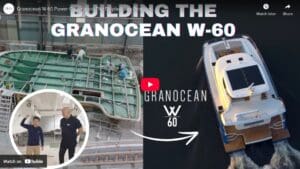Is It Really All About High Performance?
As veteran sailors know, sailing a performance catamaran with daggerboards is a thrill. The catamaran points as close into the wind as a monohull, will sail in a whisper of a breeze, can tack on a dime and will perform at breakneck speed in the right conditions.
But it’s not all about sailing super-fast for cruising sailors. We want to be comfortable and feel safe while underway and having the ability to sail in light 5 or 6 knot breezes, is one of the ultimate goals for cruisers sailing a performance catamaran.

So, while we all want to sail fast, comfort is a BIG factor and if we can achieve both at the same time, we have a winner. We wanted to be able to handle a wide range of conditions without a lot of effort and stress, and we wanted to get to our destination quickly and efficiently. Did we achieve this on the Catana 50 Ocean Class (Mithril)? Let’s take a look.
Our Personal Goals for the Catana 50 OC
 We wanted a boat that would sail in light breezes. We wanted to be able to sail at, or very close to the windspeed in the lower ranges. We achieved that easily in 5-6 knots of wind and in our Catamaran Guru Rendezvous regatta, this was never more evident when the Catana breezed past all the cruising cats in the lightest breeze. High-performance boats’ efficient lightweight design excels in light winds and seems to effortlessly glide through the water. We were thrilled with Mithril’s performance in these light winds, which means less motoring or waiting around for stronger winds for us! The Catana will cover more miles in light-wind conditions and maintain higher daily averages over time. However, in stronger winds, the Catana requires less sail area to achieve the same speed. The use of smaller sails makes handling easier and generates reduced force. This lighter force translates to less strain on the boat’s rig and for the chances of an accident.
We wanted a boat that would sail in light breezes. We wanted to be able to sail at, or very close to the windspeed in the lower ranges. We achieved that easily in 5-6 knots of wind and in our Catamaran Guru Rendezvous regatta, this was never more evident when the Catana breezed past all the cruising cats in the lightest breeze. High-performance boats’ efficient lightweight design excels in light winds and seems to effortlessly glide through the water. We were thrilled with Mithril’s performance in these light winds, which means less motoring or waiting around for stronger winds for us! The Catana will cover more miles in light-wind conditions and maintain higher daily averages over time. However, in stronger winds, the Catana requires less sail area to achieve the same speed. The use of smaller sails makes handling easier and generates reduced force. This lighter force translates to less strain on the boat’s rig and for the chances of an accident. We wanted a boat that is capable of sailing at least 250+ miles per day. Let’s face it, we all want to get there asap so if we can sail at least 250 nm daily with ease, it’s a win for us. Once in a while one also has to run from weather and having the capability to sail faster, is a plus. The incorporation of carbon fiber, Kevlar, and high-tech resins provides a high strength-to-weight ratio. As a result, the hulls are lighter and stiffer, which directly enhances the overall performance of the catamaran when under sail. The boat can handle varying wind conditions and maintain its speed and efficiency. This proved to be true in the 6000+NM that we have sailed the boat so far from Europe to the USA in all kinds of conditions.
We wanted a boat that is capable of sailing at least 250+ miles per day. Let’s face it, we all want to get there asap so if we can sail at least 250 nm daily with ease, it’s a win for us. Once in a while one also has to run from weather and having the capability to sail faster, is a plus. The incorporation of carbon fiber, Kevlar, and high-tech resins provides a high strength-to-weight ratio. As a result, the hulls are lighter and stiffer, which directly enhances the overall performance of the catamaran when under sail. The boat can handle varying wind conditions and maintain its speed and efficiency. This proved to be true in the 6000+NM that we have sailed the boat so far from Europe to the USA in all kinds of conditions. We wanted to be comfortable while underway with the least amount of pitching and slamming. The significant bridge deck clearance in Catana catamarans is designed to provide a more comfortable and safer experience for those onboard, especially when sailing in rough seas. It’s one of the reasons why these catamarans are highly regarded among sailors who prioritize comfort and performance during long passages or challenging conditions. With less slamming and pitching, the catamaran can maintain a more consistent and efficient speed, leading to better overall performance and fuel efficiency. Bridge deck clearance also affects the boat’s pitch stability. A higher clearance allows the catamaran to bridge waves more smoothly, reducing the pitching motion (the front-to-back rocking) that can be uncomfortable for passengers. Read more about catamaran bridgedeck clearance>>
We wanted to be comfortable while underway with the least amount of pitching and slamming. The significant bridge deck clearance in Catana catamarans is designed to provide a more comfortable and safer experience for those onboard, especially when sailing in rough seas. It’s one of the reasons why these catamarans are highly regarded among sailors who prioritize comfort and performance during long passages or challenging conditions. With less slamming and pitching, the catamaran can maintain a more consistent and efficient speed, leading to better overall performance and fuel efficiency. Bridge deck clearance also affects the boat’s pitch stability. A higher clearance allows the catamaran to bridge waves more smoothly, reducing the pitching motion (the front-to-back rocking) that can be uncomfortable for passengers. Read more about catamaran bridgedeck clearance>> We wanted a well-designed hull, that is lightweight with good weight distribution. This ensures that one can maintain a fairly comfortable motion and good boat speed while underway. Managing weight is indeed a critical aspect when it comes to designing and operating catamarans. it’s essential to distribute weight evenly and ensure it is well-balanced across both hulls to maintain stability in various conditions. The weight distribution on a Catana is carefully optimized to maintain a low center of gravity and enhance stability. This stability contributes to a more comfortable motion and reduces pitching. However, we did not want a boat so lightweight and a rig so powerful that it feels “tippy” in strong winds. We never felt that the sails overpowered the boat, even in some challenging conditions. The boat is a very seaworthy vessel. While it’s essential to keep weight low, it’s equally important to ensure that the materials used in the construction of the catamaran are strong and durable. The structural integrity is crucial for the safety and longevity of the vessel, especially when sailing in challenging sea conditions. Learn more about the construction and design of the Catana in this video>>
We wanted a well-designed hull, that is lightweight with good weight distribution. This ensures that one can maintain a fairly comfortable motion and good boat speed while underway. Managing weight is indeed a critical aspect when it comes to designing and operating catamarans. it’s essential to distribute weight evenly and ensure it is well-balanced across both hulls to maintain stability in various conditions. The weight distribution on a Catana is carefully optimized to maintain a low center of gravity and enhance stability. This stability contributes to a more comfortable motion and reduces pitching. However, we did not want a boat so lightweight and a rig so powerful that it feels “tippy” in strong winds. We never felt that the sails overpowered the boat, even in some challenging conditions. The boat is a very seaworthy vessel. While it’s essential to keep weight low, it’s equally important to ensure that the materials used in the construction of the catamaran are strong and durable. The structural integrity is crucial for the safety and longevity of the vessel, especially when sailing in challenging sea conditions. Learn more about the construction and design of the Catana in this video>> We wanted to live aboard in comfort. We live aboard full-time and we did not want to feel like we are permanently camping, which is the case for many performance cats in the 45 to 50 ft range. The cabins and salon in performance cats are typically small and narrow because of the very slim hull design. The Catana catamaran interior on the other hand has a very spacious owners’ cabin and a semi walk-around bed – a big plus for live aboards and the salon is enormous. The boat has enough living space for relaxing, entertaining and for storage and has spacious very comfortable cabins and bathrooms. The front deck is a great space to relax but we do miss a flybridge! However, the vast array of solar panels on the coachroof makes up for this inconvenience.
We wanted to live aboard in comfort. We live aboard full-time and we did not want to feel like we are permanently camping, which is the case for many performance cats in the 45 to 50 ft range. The cabins and salon in performance cats are typically small and narrow because of the very slim hull design. The Catana catamaran interior on the other hand has a very spacious owners’ cabin and a semi walk-around bed – a big plus for live aboards and the salon is enormous. The boat has enough living space for relaxing, entertaining and for storage and has spacious very comfortable cabins and bathrooms. The front deck is a great space to relax but we do miss a flybridge! However, the vast array of solar panels on the coachroof makes up for this inconvenience. We wanted to be able to easily handle and change sails with just the two of us even in more robust conditions and feel safe on deck and in the cockpit. The cockpit is very well-designed with plenty of space for two people. The big sliding window between the salon and cockpit always keeps you in touch with each other. The decks are wide and free of encumbrances with handholds on the coachroof. The boom is low enough to be easily reach the stackpack and a thoughtful arrangement of the deck hardware makes sail handling easier and more effective. The one challenge is the number of lines but we quickly figured that out to make it easier to identify.
We wanted to be able to easily handle and change sails with just the two of us even in more robust conditions and feel safe on deck and in the cockpit. The cockpit is very well-designed with plenty of space for two people. The big sliding window between the salon and cockpit always keeps you in touch with each other. The decks are wide and free of encumbrances with handholds on the coachroof. The boom is low enough to be easily reach the stackpack and a thoughtful arrangement of the deck hardware makes sail handling easier and more effective. The one challenge is the number of lines but we quickly figured that out to make it easier to identify. We wanted a seaworthy boat. The Catana’s construction prevents excessive flexing of the hulls under load. This is crucial as flexing can lead to issues with the rigging, specifically the leeward shrouds becoming floppy. A stiff hull ensures better stability and reduces the risk of structural problems caused by excessive movement. The Catana range is built using advanced composite materials, such as carbon fiber, Kevlar, and high-tech resins. These materials offer excellent strength-to-weight ratios, making the hulls lighter and stiffer, which translates to better performance under sail. Overall, Catana’s use of advanced composite materials and its design philosophy contribute to a vessel that is not only seaworthy and efficient but also delivers a comfortable and enjoyable sailing experience.
We wanted a seaworthy boat. The Catana’s construction prevents excessive flexing of the hulls under load. This is crucial as flexing can lead to issues with the rigging, specifically the leeward shrouds becoming floppy. A stiff hull ensures better stability and reduces the risk of structural problems caused by excessive movement. The Catana range is built using advanced composite materials, such as carbon fiber, Kevlar, and high-tech resins. These materials offer excellent strength-to-weight ratios, making the hulls lighter and stiffer, which translates to better performance under sail. Overall, Catana’s use of advanced composite materials and its design philosophy contribute to a vessel that is not only seaworthy and efficient but also delivers a comfortable and enjoyable sailing experience.
The conclusion is that while we changed a few things like the anchoring system and salon table, we know that the boat is seaworthy, performs well in all sailing conditions and meets most of our criteria for a performance cruising catamaran. The biggest compromise is the flybridge that we really enjoyed on our previous boat but it makes up for it by getting us places a whole lot faster.
Our goals for the Catana on full display






